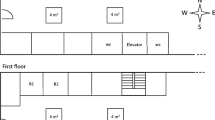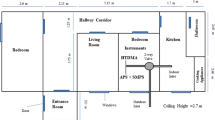Abstract
Many studies have been carried out on the environmental impact of the research stations on the Antarctic continent. However, the assessment of indoor air quality in these confined environments has been neglected. The main objectives of this study are to investigate the granulometric distribution of the indoor particles in the different compartments of the Brazilian Antarctic Station, to examine the number and mass concentration of the indoor particles, to conduct chemical and morphological analyses of the indoor PM2.5, and to identify the possible sources of the PM. The results showed that Na, K, Cl, Fe, Zn, S and Si were the main elements detected. High levels of black carbon were recorded in the workshop, which may be associated with the use of diesel vehicles. To identify the human activities related to the indoor particle emission in the station, the size distribution of the particles in the living room was monitored for seven consecutive days, during normal station operation. It was possible to identify the influence of individual processes, such as incineration, cooking and the movement of people, upon the particle size number concentration. The indoor/outdoor (I/O) ratio for the total suspended particles (TSP), PM10, PM2.5 and PM1 measured was significantly larger than those reported for urban buildings. In general, the I/O ratio distribution for all the compartments shows peak values between 2.5 and 10 μm, which is often related to human activity, such as cleaning, personnel circulation or clothing surfaces. The maximum I/O ratio at this range varied from 12 to 60. In addition, the compartments affected by combustion processes tend to present a significant number of submicron particles.









Similar content being viewed by others
References
Abt, E., Suh, H. H., Catalano, P., & Koutrakis, P. (2000). Relative contribution of outdoor and indoor particle sources to indoor concentrations. Environmental Science and Technology, 34(17), 3579–3587. doi:10.1021/es990348y.
Albuquerque, T. T. de A., Andrade, M. de F., & Ynoue, R. Y. (2012). Characterization of atmospheric aerosols in the city of São Paulo, Brazil: comparisons between polluted and unpolluted periods. Environmental Monitoring and Assessment, 184(2), 969–984. doi:10.1007/s10661-011-2013-y
Alvarez, C. E. De, Casagrande, B., & Soares, G. R. (2007). Resultados alcançados com a implementação do plano diretor da Estação Antártica Comandante Ferraz. In IV Encontro Nacional e II Encontro Latino-Americano sobre Edificações e Comunidades Sustentáveis (pp. 1297–1306). Mato Grosso do Sul, Brasil: UFMS.
Annesi-Maesano, I., Moreau, D., Caillaud, D., Lavaud, F., Le Moullec, Y., Taytard, A., et al. (2007). Residential proximity fine particles related to allergic sensitisation and asthma in primary school children. Respiratory Medicine, 101(8), 1721–1729. doi:10.1016/j.rmed.2007.02.022.
ANVISA Agência Nacional de Vigilância Sanitária. Resolução—RE no 9, de 16 de janeiro de 2003 (2003). Brasil: Diário Oficial da União.
Buonanno, G., Stabile, L., Morawska, L., & Russi, A. (2013). Children exposure assessment to ultrafine particles and black carbon: the role of transport and cooking activities. Atmospheric Environment, 79, 53–58. doi:10.1016/j.atmosenv.2013.06.041.
Calvo, A. I., Alves, C., Castro, A., Pont, V., Vicente, A. M., & Fraile, R. (2013). Research on aerosol sources and chemical composition: past, current and emerging issues. Atmospheric Research, 120–121, 1–28. doi:10.1016/j.atmosres.2012.09.021.
Chithra, V. S., & Shiva Nagendra, S. M. (2013). Chemical and morphological characteristics of indoor and outdoor particulate matter in an urban environment. Atmospheric Environment, 77, 579–587. doi:10.1016/j.atmosenv.2013.05.044.
Géhin, E., Ramalho, O., & Kirchner, S. (2008). Size distribution and emission rate measurement of fine and ultrafine particle from indoor human activities. Atmospheric Environment, 42(35), 8341–8352. doi:10.1016/j.atmosenv.2008.07.021.
Godish, T. (2003). Air quality (4th edition). Chelsea, Michigan: Lewis Publishers.
Gupta, S., Srivastava, A., & Jain, V. K. (2008). Particle size distribution of aerosols and associated heavy metals in kitchen environments. Environmental Monitoring and Assessment, 142(1–3), 141–148. doi:10.1007/s10661-007-9915-8.
He, C., Morawska, L., Hitchins, J., & Gilbert, D. (2004). Contribution from indoor sources to particle number and mass concentrations in residential houses. Atmospheric Environment, 38(21), 3405–3415. doi:10.1016/j.atmosenv.2004.03.027.
Health Canada. Residential indoor air quality guidelines (2014). Canada. www.hc-sc.gc.ca
Huang, S. L., Yin, C. Y., & Yap, S. Y. (2010). Particle size and metals concentrations of dust from a paint manufacturing plant. Journal of Hazardous Materials, 174(1–3), 839–842. doi:10.1016/j.jhazmat.2009.09.129.
Isaxon, C., Gudmundsson, A., Nordin, E. Z., Lönnblad, L., Dahl, A., Wieslander, G., et al. (2015). Contribution of indoor-generated particles to residential exposure. Atmospheric Environment, 106, 458–466. doi:10.1016/j.atmosenv.2014.07.053.
Li, C. S. (1994). Elemental composition of residential indoor PM10 in the urban atmosphere of Taipei. Atmospheric Environment, 28(19), 3139–3144. doi:10.1016/1352-2310(94)00153-C.
Loreiro, A. L., Ribeiro, A. C., Artaxo, P., & Yamasoe, M. A. (1994). Calibration of reflectometer system to measure black carbon and field intercomparation in the Amazon Basin (In 5th international conference on carbonaceous particles in the atmosphere). California, USA: Berkley.
Mazzera, D. M., Lowenthal, D. H., Chow, J. C., Watson, J. G., & Grubǐsíc, V. (2001). PM10 measurements at McMurdo Station, Antarctica. Atmospheric Environment, 35(10), 1891–1902. doi:10.1016/S1352-2310(00)00409-X.
McDonagh, A., & Byrne, M. A. (2014). A study of the size distribution of aerosol particles resuspended from clothing surfaces. Journal of Aerosol Science, 75, 94–103. doi:10.1016/j.jaerosci.2014.05.007.
Mishra, V. K., Kim, K. H., Hong, S., & Lee, K. (2004). Aerosol composition and its sources at the King Sejong Station, Antarctic peninsula. Atmospheric Environment, 38(24), 4069–4084. doi:10.1016/j.atmosenv.2004.03.052.
Morawska, L., & Salthammer, T. (2003). Indoor environment. Weinheim: Wiley-VCH Verlag GmbH & Co.. doi:10.1002/9783527610013.
Morawska, L., Afshari, A., Bae, G. N., Buonanno, G., Chao, C. Y. H., Hanninen, O., Hofmann, W., Isaxon, C., Jayaratne, E. R., Pasanen, P., Salthammer, T., Waring, M., & Wierzbicka, A. (2013). Indoor aerosols: from personal exposure to risk assessment. Indoor Air, 23, 467–487.
NAAQS/EPA. National Ambient Air Quality Standards (2012). USA: U.S. Environmental Protection Agency. http://www.epa.gov
Pant, V., Siingh, D., & Kamra, A. K. (2011). Size distribution of atmospheric aerosols at Maitri, Antarctica. Atmospheric Environment, 45(29), 5138–5149. doi:10.1016/j.atmosenv.2011.06.028.
Pereira, E. B., Loureiro, A. L. M., & Vasconsellos, M. B. V. (1992). Reconnaissance of elemental composition in aerosols of the Antarctic Peninsula. Atmospheric Environment. Part A. General Topics, 26(8), 1549–1550. doi:10.1016/0960-1686(92)90139-C.
Qian, J., Peccia, J., & Ferro, A. R. (2014). Walking-induced particle resuspension in indoor environments. Atmospheric Environment, 89, 464–481. doi:10.1016/j.atmosenv.2014.02.035.
Santos, J. M., Mavroidis, I., Reis, N. C., & Pagel, E. C. (2011). Experimental investigation of outdoor and indoor mean concentrations and concentration fluctuations of pollutants. Atmospheric Environment, 45(36), 6534–6545. doi:10.1016/j.atmosenv.2011.08.049.
SCE—Sistema Nacional de Certificação Energética da Qualidade do Ar Interior nos Edifícios. Nota Técnica NT-SCE-02 Metodologia para auditorias periódicas de Qualidade do Ar Interior em edifícios de serviços existentes no âmbito do RSECE (2009). Portugal. http://www.adene.pt/pt-pt/SubPortais/SCE/Destaques/Paginas/Notatecnica2.aspx
Seaman, V. Y., Bennett, D. H., & Cahill, T. M. (2009). Indoor acrolein emission and decay rates resulting from domestic cooking events. Atmospheric Environment, 43, 6199–6204. doi:10.1016/j.atmosenv.2009.08.043.
Seinfeld, J. H., & Pandis, S. N. (2006). Atmospheric chemistry and physics from Air pollution to climate change (Second edi.). Hoboken, New Jersey: Wiley.
Tan, C. C. L., Finney, K. N., Chen, Q., et al. (2013). Experimental investigation of indoor air pollutants in residential buildings. Indoor and Built Environment, 22, 471–489. doi:10.1177/1420326X12441806.
Teinilä, K., Frey, A., Hillamo, R., Tülp, H. C., & Weller, R. (2014). A study of the sea-salt chemistry using size-segregated aerosol measurements at coastal Antarctic station Neumayer. Atmospheric Environment, 96, 11–19. doi:10.1016/j.atmosenv.2014.07.025.
The European Standard. EN ISO 16000–1: indoor air—general aspects of sampling strategy (2006).
Uhde, E., Schulz, N., Delius, W., & Markewitz, D. (2015). Impact of air fresheners on indoor air quality. Atmospheric Environment, 106(Figure 1), 492–502. doi:10.1016/j.atmosenv.2014.11.020.
Viana, M., Díez, S., & Reche, C. (2011). Indoor and outdoor sources and infiltration processes of PM1 and black carbon in an urban environment. Atmospheric Environment, 45(35), 6359–6367. doi:10.1016/j.atmosenv.2011.08.044.
Wallace, L., Williams, R., Rea, A., & Croghan, C. (2006). Continuous weeklong measurements of personal exposures and indoor concentrations of fine particles for 37 health-impaired North Carolina residents for up to four seasons. Atmospheric Environment, 40(3), 399–414. doi:10.1016/j.atmosenv.2005.08.042.
Wan, M. P., Wu, C. L., Sze To, G. N., Chan, T. C., & Chao, C. Y. H. (2011). Ultrafine particles, and PM2.5 generated from cooking in homes. Atmospheric Environment, 45(34), 6141–6148. doi:10.1016/j.atmosenv.2011.08.036.
Weinstein, J. P., Hedges, S. R., & Kimbrough, S. (2010). Characterization and aerosol mass balance of PM2.5 and PM10 collected in Conakry, Guinea during the 2004 Harmattan period. Chemosphere, 78(8), 980–988. doi:10.1016/j.chemosphere.2009.12.022.
WHO Regional Office for Europe. (2010). WHO guidelines for indoor air quality. Nutrition Journal, 9, 454. doi:10.1186/2041-1480-2-S2-I1.
Wolkoff, P., & Kjærgaard, S. K. (2007). The dichotomy of relative humidity on indoor air quality. Environment International, 33(6), 850–857. doi:10.1016/j.envint.2007.04.004.
Acknowledgements
The authors wish to thank the FAPES/CNPQ PRONEX, CAPES, INCT-APA, PROANTAR and FINEP, for financial or equipment support, and the Brazilian Navy and Air Force for their logistical support. We would like to dedicate this work to the memory of Sargent Roberto Lopes dos Santos and Soldier Carlos Alberto Vieira Figueiredo, who both died in their heroic attempts to control the fire at the Comandante Ferraz Antarctic Station in February 2012.
Author information
Authors and Affiliations
Corresponding author
Rights and permissions
About this article
Cite this article
Pagel, É.C., Costa Reis, N., de Alvarez, C.E. et al. Characterization of the indoor particles and their sources in an Antarctic research station. Environ Monit Assess 188, 167 (2016). https://doi.org/10.1007/s10661-016-5172-z
Received:
Accepted:
Published:
DOI: https://doi.org/10.1007/s10661-016-5172-z




